Input interpretation

3-methylpyridine
Chemical names and formulas

formula | C_6H_7N name | 3-methylpyridine alternate names | 3-picoline | beta-methylpyridine | beta-picoline | m-picoline | pyridine, 3-methyl- mass fractions | C (carbon) 77.4% | H (hydrogen) 7.58% | N (nitrogen) 15%
Lewis structure
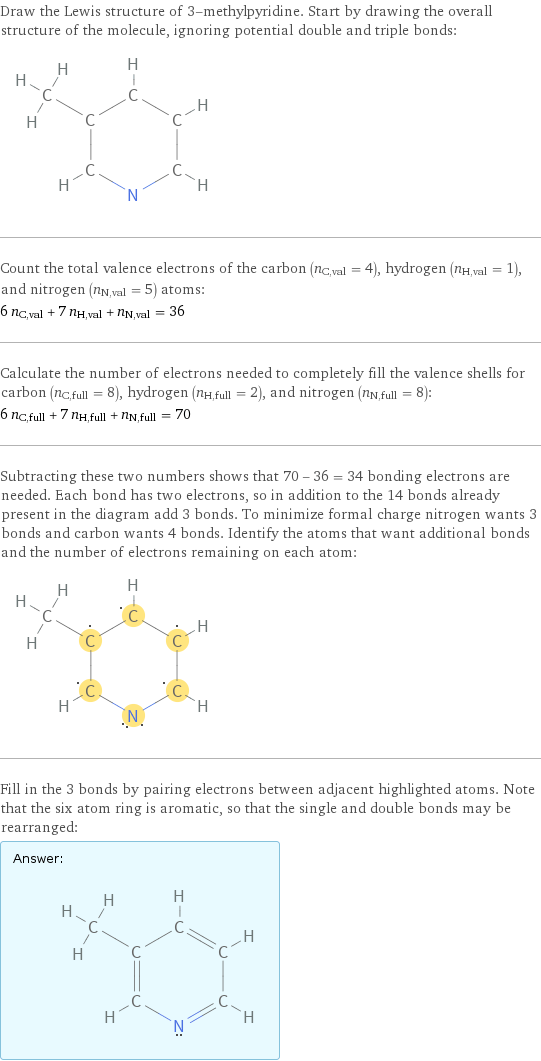
Draw the Lewis structure of 3-methylpyridine. Start by drawing the overall structure of the molecule, ignoring potential double and triple bonds: Count the total valence electrons of the carbon (n_C, val = 4), hydrogen (n_H, val = 1), and nitrogen (n_N, val = 5) atoms: 6 n_C, val + 7 n_H, val + n_N, val = 36 Calculate the number of electrons needed to completely fill the valence shells for carbon (n_C, full = 8), hydrogen (n_H, full = 2), and nitrogen (n_N, full = 8): 6 n_C, full + 7 n_H, full + n_N, full = 70 Subtracting these two numbers shows that 70 - 36 = 34 bonding electrons are needed. Each bond has two electrons, so in addition to the 14 bonds already present in the diagram add 3 bonds. To minimize formal charge nitrogen wants 3 bonds and carbon wants 4 bonds. Identify the atoms that want additional bonds and the number of electrons remaining on each atom: Fill in the 3 bonds by pairing electrons between adjacent highlighted atoms. Note that the six atom ring is aromatic, so that the single and double bonds may be rearranged: Answer: | |
3D structure
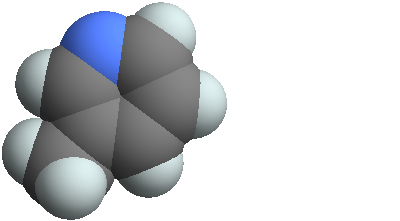
3D structure
Basic properties
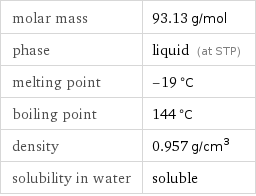
molar mass | 93.13 g/mol phase | liquid (at STP) melting point | -19 °C boiling point | 144 °C density | 0.957 g/cm^3 solubility in water | soluble
Units

Hydrophobicity and permeability properties

experimental LogP hydrophobicity | 1.2 predicted LogP hydrophobicity | 1.11 predicted LogS | 0.33
Basic drug properties

approval status | experimental | small molecule
Liquid properties (at STP)
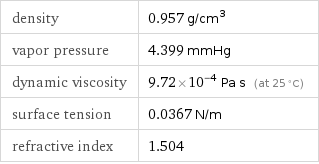
density | 0.957 g/cm^3 vapor pressure | 4.399 mmHg dynamic viscosity | 9.72×10^-4 Pa s (at 25 °C) surface tension | 0.0367 N/m refractive index | 1.504
Units

Thermodynamic properties
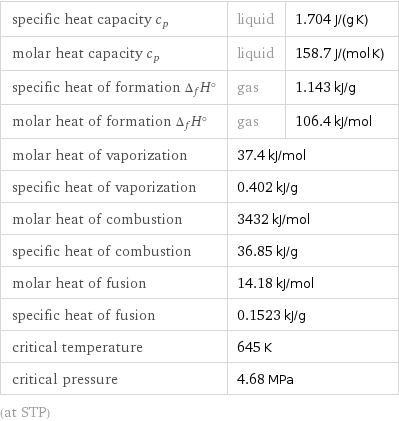
specific heat capacity c_p | liquid | 1.704 J/(g K) molar heat capacity c_p | liquid | 158.7 J/(mol K) specific heat of formation Δ_fH° | gas | 1.143 kJ/g molar heat of formation Δ_fH° | gas | 106.4 kJ/mol molar heat of vaporization | 37.4 kJ/mol | specific heat of vaporization | 0.402 kJ/g | molar heat of combustion | 3432 kJ/mol | specific heat of combustion | 36.85 kJ/g | molar heat of fusion | 14.18 kJ/mol | specific heat of fusion | 0.1523 kJ/g | critical temperature | 645 K | critical pressure | 4.68 MPa | (at STP)
Molecular properties
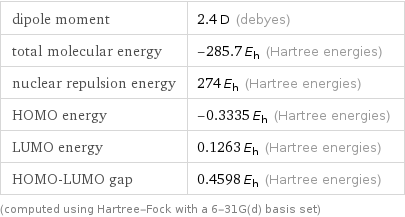
dipole moment | 2.4 D (debyes) total molecular energy | -285.7 E_h (Hartree energies) nuclear repulsion energy | 274 E_h (Hartree energies) HOMO energy | -0.3335 E_h (Hartree energies) LUMO energy | 0.1263 E_h (Hartree energies) HOMO-LUMO gap | 0.4598 E_h (Hartree energies) (computed using Hartree-Fock with a 6-31G(d) basis set)
Chemical identifiers
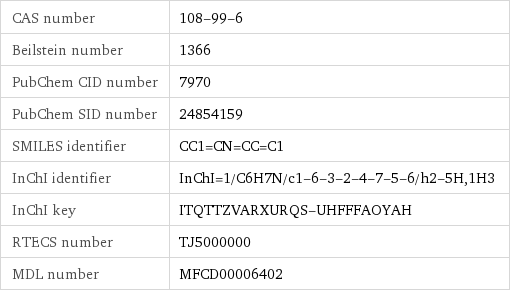
CAS number | 108-99-6 Beilstein number | 1366 PubChem CID number | 7970 PubChem SID number | 24854159 SMILES identifier | CC1=CN=CC=C1 InChI identifier | InChI=1/C6H7N/c1-6-3-2-4-7-5-6/h2-5H, 1H3 InChI key | ITQTTZVARXURQS-UHFFFAOYAH RTECS number | TJ5000000 MDL number | MFCD00006402
NFPA label

NFPA label
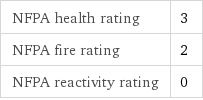
NFPA health rating | 3 NFPA fire rating | 2 NFPA reactivity rating | 0
Safety properties
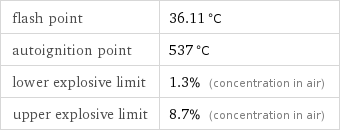
flash point | 36.11 °C autoignition point | 537 °C lower explosive limit | 1.3% (concentration in air) upper explosive limit | 8.7% (concentration in air)

DOT hazard class | 3 DOT numbers | 2313
Toxicity properties

RTECS classes | tumorigen | primary irritant